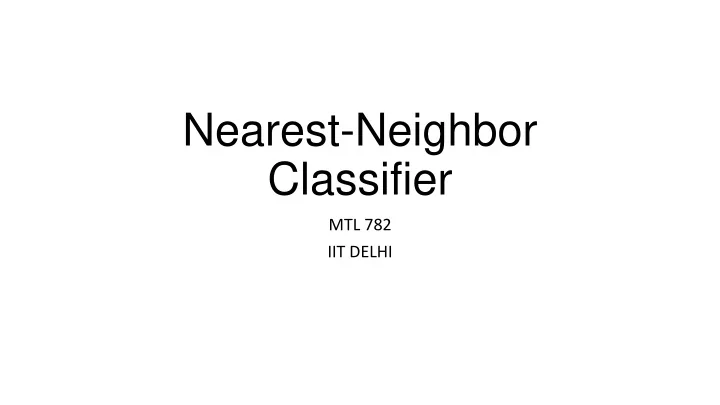

Nearest-Neighbor Classifier MTL 782 IIT DELHI
Instance-Based Classifiers Set of Stored Cases • Store the training records • Use training records to ……... Atr1 AtrN Class predict the class label of A unseen cases B B Unseen Case C ……... Atr1 AtrN A C B
Instance Based Classifiers • Examples: – Rote-learner • Memorizes entire training data and performs classification only if attributes of record match one of the training examples exactly – Nearest neighbor • Uses k “closest” points (nearest neighbors) for performing classification
Nearest Neighbor Classifiers • Basic idea: – If it walks like a duck, quacks like a duck, then it’s probably a duck Compute Test Distance Record Training Choose k of the “nearest” records Records
Nearest-Neighbor Classifiers Unknown record Requires three things l – The set of stored records – Distance Metric to compute distance between records – The value of k , the number of nearest neighbors to retrieve To classify an unknown record: l – Compute distance to other training records – Identify k nearest neighbors – Use class labels of nearest neighbors to determine the class label of unknown record (e.g., by taking majority vote)
Definition of Nearest Neighbor X X X (a) 1-nearest neighbor (b) 2-nearest neighbor (c) 3-nearest neighbor K-nearest neighbors of a record x are data points that have the k smallest distance to x
1 nearest-neighbor Voronoi Diagram
Nearest Neighbor Classification • Compute distance between two points: – Euclidean distance d ( p , q ) ( p q ) 2 i i i – Manhatten distance 𝑒 𝑞, 𝑟 = 𝑞 𝑗 − 𝑟 𝑗 𝑗 – q norm distance ) 1/𝑟 𝑒 𝑞, 𝑟 = ( 𝑞 𝑗 − 𝑟 𝑗 𝑟 𝑗
• Determine the class from nearest neighbor list – take the majority vote of class labels among the k-nearest neighbors y’ = argmax 𝐽( 𝑤 = 𝑧 𝑗 ) 𝒚 𝑗 ,𝑧 𝑗 ϵ 𝐸 𝑨 𝑤 where D z is the set of k closest training examples to z. – Weigh the vote according to distance y’ = argmax 𝑥 𝑗 × 𝐽( 𝑤 = 𝑧 𝑗 ) 𝒚 𝑗 ,𝑧 𝑗 ϵ 𝐸 𝑨 𝑤 • weight factor, w = 1/d 2
The KNN classification algorithm Let k be the number of nearest neighbors and D be the set of training examples. 1. for each test example z = ( x ’,y’) do 2. Compute d( x ’, x ), the distance between z and every example, ( x ,y) ϵ D 3. Select D z ⊆ D, the set of k closest training examples to z. 4. y’ = argmax 𝐽( 𝑤 = 𝑧 𝑗 ) 𝒚 𝑗 ,𝑧 𝑗 ϵ 𝐸 𝑨 𝑤 5. end for
KNN Classification $2,50,000 $2,00,000 $1,50,000 Non-Default Loan$ Default $1,00,000 $50,000 $0 0 10 20 30 40 50 60 70 Age
Nearest Neighbor Classification… • Choosing the value of k: – If k is too small, sensitive to noise points – If k is too large, neighborhood may include points from other classes X
Nearest Neighbor Classification… • Scaling issues – Attributes may have to be scaled to prevent distance measures from being dominated by one of the attributes – Example: • height of a person may vary from 1.5m to 1.8m • weight of a person may vary from 60 KG to 100KG • income of a person may vary from Rs10K to Rs 2 Lakh
Nearest Neighbor Classification… • Problem with Euclidean measure: – High dimensional data • curse of dimensionality: all vectors are almost equidistant to the query vector – Can produce undesirable results 1 1 1 1 1 1 1 1 1 1 1 0 1 0 0 0 0 0 0 0 0 0 0 0 vs 0 1 1 1 1 1 1 1 1 1 1 1 0 0 0 0 0 0 0 0 0 0 0 1 d = 1.4142 d = 1.4142 Solution: Normalize the vectors to unit length
Nearest neighbor Classification… • k-NN classifiers are lazy learners – It does not build models explicitly – Unlike eager learners such as decision tree induction and rule-based systems – Classifying unknown records are relatively expensive
Thank You
Recommend
More recommend